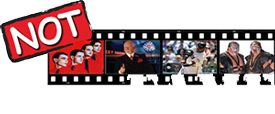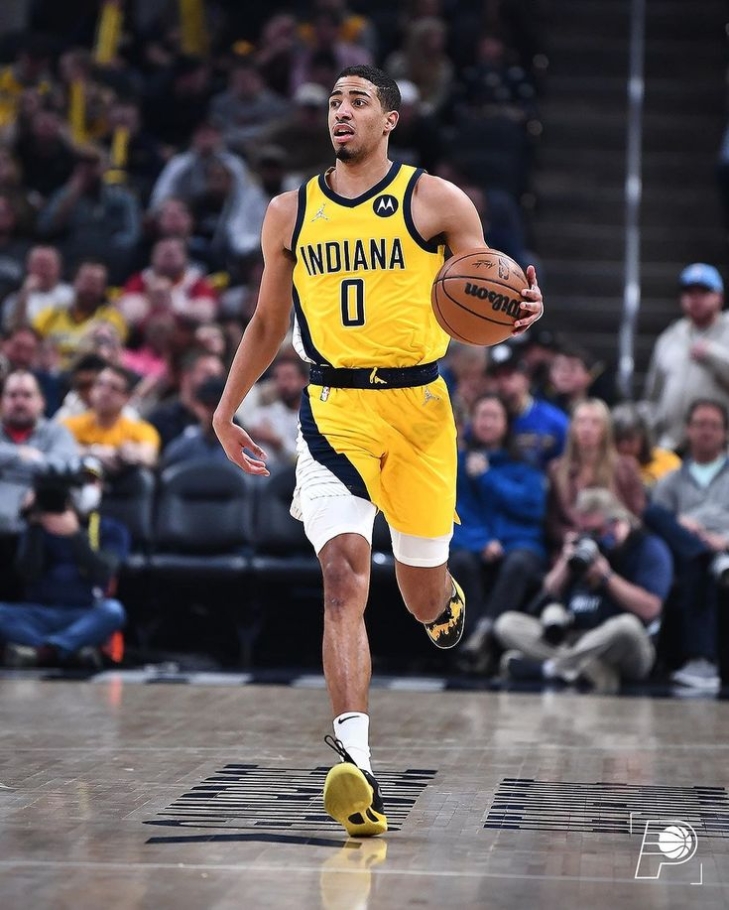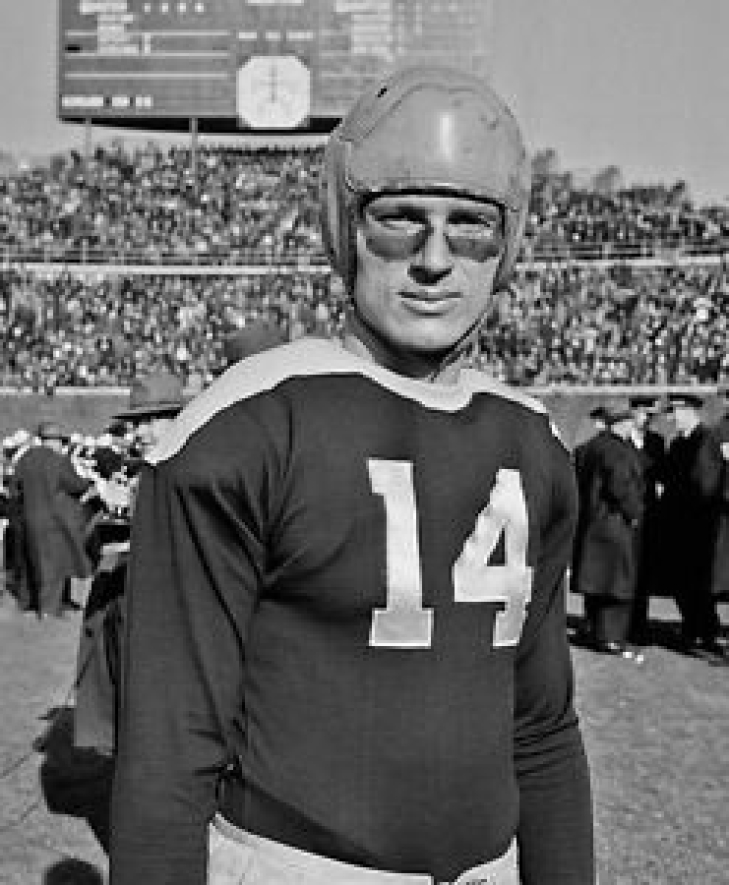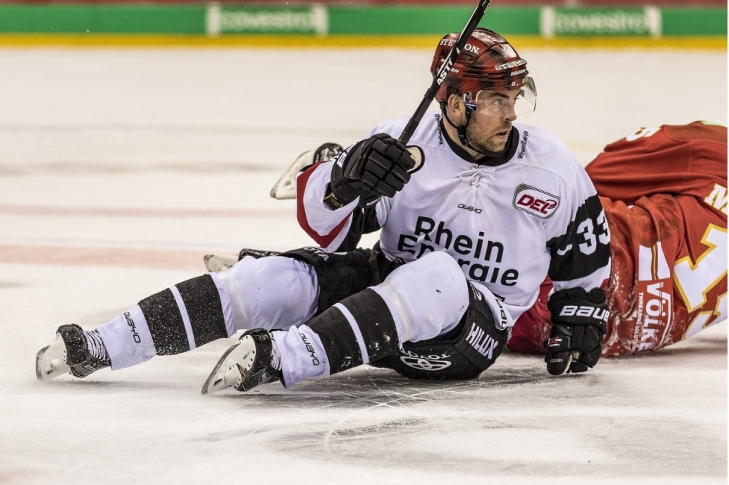
Committee Chairman
24. Tyrese Haliburton
Tyrese Haliburton was traded from Sacramento to Indiana in a deal that can best be described as both teams in rebuilding mode trying to see what might fit. Sacramento made the playoffs first after the deal, but the Pacers landed a player who became an All-Star.
In Indiana, Haliburton had the opportunity to become more of a focal point, and he finished the 2021-22 season with the Pacers with 17.5 Points per Game over 26 contests. In 2022-23, Haliburton started the year on fire, and he went to his first All-Star Game. Now the top performer of his squad, Haliburton, who was injured late in the year but had the best season of his life with a double-double average of 10.1 Assists and 20.7 Points. He was even better last season, earning a Third Team All-NBA, another All-Star, and his first Assists Title with 10.9. Haliburton also averaged over 20 Points per Game (20.1), and took the Pacers to the Eastern Conference Finals.
As Haliburton is still well under 30, we could see multiple All-Stars in his future.
The Pittsburgh Penguins will retire Jaromir Jagr's number
Regular visitors of Notinhalloffame.com know that we are slowly working on the top 50 of every major team in the NHL, NBA, NFL and MLB. Once that is done, we intend to look at how each team honor their past players, coaches and executives. As such, it is important to us that the
Pittsburgh Penguins will be retiring the number 68 of Jaromir Jagr on February 18.
Jagr scored 1,079 of his 1,733 career NHL Points with Pittsburgh, a team he played 11 seasons (1990-91 to 2000-01), won the 1998-Hart Trophy, five Art Ross Trophies and won two Stanley Cups (1991 & 1992).
Jagr currently owns the Kladno Knights of the Czech League, who he played for last year, and could still again, as he has not yet officially retired despite being 51. The Hockey Hall of Fame does not consider a player eligible until he stopped playing hockey in all major competitive leagues, hence why Jagr, who last played in the NHL in 2018, is not yet inducted.
He will become the third player to have his number retired by the Penguins, following Michael Briere (#21) and Mario Lemieux (#66).
We here at Notinhalloffame.com would like to congratulate Jaromir Jagr for his impending honor.
The Pro Football Hall of Fame Revisited Project: 1951 FINAL VOTE
1951 Pro Football Hall of Fame Revisited Project Class.
Here we are! Again!!
If you have been following our Pro Football Hall of Fame Revisited Project, you know that we have asked the rhetorical question…what if the PFHOF began in January of 1946?
After soliciting and obtaining a passionate group of football fans and historians, we sent out a ballot for a Preliminary Vote, which we asked each voter to give us 25 names as their semi-finalists, and 5 in the Senior Pool. Following that, we asked the group to vote for their 15 Finalists in the Modern Era, and 3 in the Senior Category. The final stage was to vote for their five Modern Era inductee, one Senior inductee and one Coaches/Contributor inductee.
This is the result of the sixth official class;
Below, are the final results of this project based on 30 votes:
This is for the “Modern Era”
*Bold indicates they have been elected to the Pro Football Hall of Fame Revisited Class of 1951:
|
Player |
Year of Eligibility |
Vote Total |
|
Don Hutson E-DB-DE |
1 |
28 |
|
Mel Hein C-LB |
1 |
23 |
|
Bill Hewitt E-DE |
3 |
15 |
|
Walt Kiesling G-T |
8 |
14 |
|
Ray Flaherty E-DE |
11 |
11 |
|
Dutch Sternaman HB-QB-FB |
19 |
12 |
|
Ox Emerson G-C |
8 |
11 |
|
Arnie Herber TB-HB-DB-QB-BB |
1 |
9 |
|
Tuffy Leemans FB-TB-DB-QB |
3 |
7 |
|
George Musso G-T |
2 |
6 |
|
Swede Youngstrom G-T-E-C |
19 |
5 |
|
Jimmy Conzelman HB-TB-BB-E |
17 |
4 |
|
Turk Edwards T |
6 |
3 |
|
Red Badgro E-DE |
10 |
2 |
|
Beattie Feathers HB-WB |
6 |
2 |
|
Cecil Isbel TB-HB |
4 |
1 |
This is for the “Senior Era”
As none of the Senior Candidates obtained 50 percent of the vote, no Senior Candidate was chosen. This is the second year where this rule was instituted. Please note that voters could also opt out of this vote, as per the request of members of the voting body.
|
Blondy Wallace |
6 |
10 |
|
Cub Buck |
1 |
7 |
|
Hunk Anderson |
1 |
6 |
This is for the Coaches/Contributors
*Bold indicates they have been elected to the Pro Football Hall of Fame Revisited Class of 1951:
|
Joseph Carr |
2 |
15 |
|
Ralph Hay |
2 |
11 |
|
Jimmy Conzelman |
2 |
4 |
About the 1951 Inductees:
Don Hutson E-DB-DE, GNB 1935-45: Inducted in 1951 on his 1st Ballot. Was inducted into the actual Pro Football Hall of Fame in 1963.
An All-American and NCAA Champion at Alabama, Don Hutson became Football’s first “Super End”. Hutson was arguably the game’s first real Receiver, originating passing routes and combining his unique skills and athleticism to become a legend. Hutson led the league in Receptions and Receiving Touchdowns eight times, Receiving Yards seven times was a three-time NFL Champion with Green Bay, and was an eight-time First Team All-Pro. He would also be named the league MVP twice. When he retired, he was 200 higher than anyone else in Receptions. As this was the 60-minute era, Hutson played on defense where he recorded 30 Interceptions, making one of the better Defensive Backs of his era. How could he not enter on the first ballot?
Mel Hein C-LB, NYG 1931-45: Inducted in 1951 on his 1st Ballot. Was inducted into the actual Pro Football Hall of Fame in 1963.
Mel Hein was one of the first great players from Washington State, and it was the New York Giants who were able to sign him in 1931. This was the team he stayed with for his entire career, which ended in 1945. Hein led the New York Giants to two NFL Championships, and the two-way player (Center and Linebacker) never missed a game. Hein was an All-Pro in eight consecutive years and was named the league MVP in 1938, and he joins Hutson as a first ballot inductee.
Bill Hewitt E-DE, CHI 1932-36, PHI 1937-49 & 1943: Inducted in 1951 on his 3rd Ballot. Was inducted into the actual Pro Football Hall of Fame in 1981.
Bill Hewitt might have been best known for his refusal to wear a helmet, a stance he held until it was league-mandated, but this tough-as-nails player was a dominant two-way end and one of the top football players of the 1930s.
Hewitt played for the Chicago Bears from 1932 to 1936, propelling them to two NFL Championships. A very good player on offense (he led the NFL in Touchdown Receptions in 1935), he was positively devastating on defense. Known as the “Offside Kid” for his penchant for jumping the snap, Hewitt has blistering speed for his day and was often the best defensive player on the field.
He finished his career with the Philadelphia Eagles, playing until 1939, save for a brief comeback when the team was shorthanded in 1943 due to World War II.
Walt Kiesling G-T, DUL 1926-37, POT 1928, CRD 1929-33, 1934 CHI, GNB 1935-36. PIT 1937-38: Inducted in 1951 on his 6th Ballot (technically his 8th year of eligibility). Was inducted into the actual Pro Football Hall of Fame in 1966.
A large man for his time, Walt Kiesling was one of the top linemen of the 1920s, doing the grunt work that opened holes on offense and closed them on defense. Kiesling played for multiple teams, most notably for the Chicago Bears in 1934, who were undefeated, and the 1936 NFL Championship Green Bay Packers.
Ray Flaherty E, NYY 1937-38, NYG 1927-35: Inducted in 1951 on his 6th Ballot (technically his 11th year of eligibility). Was inducted into the actual Pro Football Hall of Fame in 1976 as a Coach.
A seven-year veteran player at End for New York (both the Yankees and Giants), Flaherty signed on with the Boston Redskins as their Head Coach in 1936. The team relocated to Washington the following year, and the Redskins won the NFL Championship, and did so again in 1942. An innovator of offense, Flaherty is credited with inventing the screen pass among other schemes. Despite that coaching prowess, he enters the Pro Football Hall of Fame Revisited Project as a player, where he was a three-time First Team All-Pro, won a Receiving Title and an NFL Championship.
Joe Carr: Inducted in 1951 on the 2nd Coaches/Contributor Ballot. Was inducted into the actual Pro Football Hall of Fame in 1963.
Joe Carr is responsible for much of the structure that exists in the National Football League, and he did it simply by learning and executing what worked in Major League Baseball. A newspaper man from Columbus, Carr revived the Columbus Panhandles Football Team in 1907. The Panhandles would be a charter member of the NFL, and Carr, due to his vision, became the league’s first President; a position he held until his death in 1939. Carr brought structure to the NFL, organizing how college players could migrate to the NFL, and his no-nonsense approach might have been a hardline one, but without it, the existence of the league could have been in doubt.
A Beginner’s Guide to Canadian Sportsbooks: What You Need to Know
For those new to the world of sports wagering in Canada, starting your adventure at a sportsbook can be both exhilarating and daunting. A sportsbook is an establishment that accepts wagers on various sporting events. From the icy arenas of hockey to the gridirons of football, these institutions cater to a plethora of athletic competitions.
Legal Landscape: Betting in Canada
Before placing your first wager, it’s imperative to comprehend the legalities of sports wagering in the Great White North. Recently, Canada, more specifically Ontario, has witnessed a transformation in its gambling laws, particularly with the legalization of single-event sports wagering. This legal shift opens a window of opportunity for enthusiasts to engage in this pastime responsibly.
Selecting Your Sportsbook: A Guided Choice
Choosing the right sportsbook is a critical first step. Look for establishments, like FanDuel Canada, that are reputable and offer a secure platform for transactions. It’s advisable to peruse reviews and investigate their licensing to ensure a legitimate and protected betting environment.
Diving into the Odds: The Heart of Sportsbooks
The essence of sports wagering lies in understanding odds, which are the probabilities of an event's outcome. Odds can be displayed in various formats, such as decimal, fractional, or American. Grasping how these odds translate into potential winnings is crucial for a successful foray into sports wagering.
The Art of the Wager: Types of Bets
Wagering is not merely about predicting winners and losers. Various bets offer different levels of risk and reward. Some common types include:
- Moneyline Bets: Choosing a team or player to win outright.
- Point Spread Bets: Wagering on the margin of victory.
- Over/Under Bets: Predicting the total points scored in a game.
- Proposition Bets: Betting on specific occurrences or non-occurrences during an event.
Each type of bet requires a different strategic approach and offers a unique thrill.
Managing Your Bankroll: The Keystone of Wagering Wisdom
Financial prudence is the keystone of wagering wisdom. It’s essential to set a budget and adhere to it. This not only ensures that you gamble within your means but also enhances the enjoyment of the experience. Remember, the goal is to relish the ride, not to derail your finances.
Strategies and Tips: Sharpening Your Edge
While there’s no guaranteed formula for success in sports wagering, certain strategies can sharpen your competitive edge. Educating yourself about the sports you’re betting on, understanding the dynamics of the teams and players, and analyzing statistical data can all contribute to more informed decision-making.
The Social Component: Sportsbooks as a Hub
Sportsbooks often serve as social hubs where fans gather to watch games and share in the collective excitement. This camaraderie can add to the enjoyment, offering a way to connect with fellow enthusiasts and engage in friendly discourse.
Staying Informed: Keeping Abreast of Changes
The sports wagering landscape is ever-evolving. Staying informed about changes in laws, sportsbook offerings, and betting technologies can enhance your experience and keep you ahead of the curve.
Conclusion: The Adventure Awaits
Embarking on your journey through Canadian sportsbooks should be an enjoyable and thrilling pursuit. With the proper knowledge and a strategic approach, you can navigate the world of sports wagering with confidence. Remember, the objective is to have fun, wager responsibly, and perhaps, with a bit of luck and skill, come out on top.





